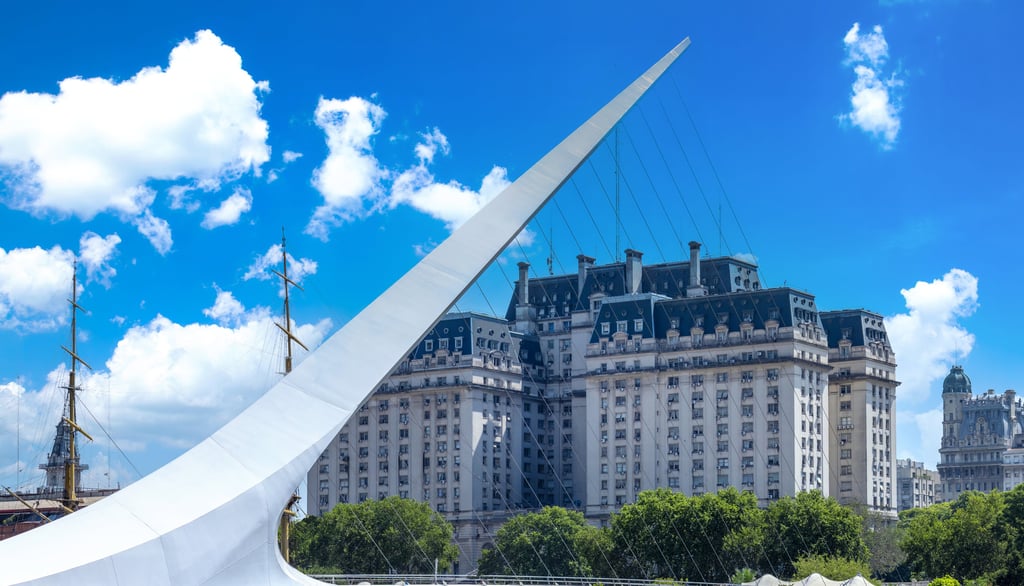From Colonial Courtyards to Glass Towers: 10 Must-See Places in Buenos Aires
Wander through tango-filled alleys, grand opera halls, and cafés frozen in time. This guide reveals the places where Buenos Aires tells its story—through poetry, pizza, and riverside dreams.
PLACESTRAVELBUENOS AIRES
5/3/20254 min read


Buenos Aires is a city of moods and mirrors—a place where past and present endlessly echo each other. Known as “The Paris of South America” for its broad boulevards, Belle Époque architecture, and romantic cafés, the city also pulses with Latin passion and a strong immigrant heartbeat. With every step, you’ll find contrasts: aristocratic mansions standing next to humble tenements, baroque churches giving way to glass skyscrapers, solemn poetry dissolving into laughter over pizza.
To know Buenos Aires is to dance between its dualities—European and American, modern and antique, river and stone. As Borges once wrote, “No nos une el amor, sino el espanto… será por eso que la quiero tanto.” Perhaps that’s why we love Buenos Aires—not for its perfection, but for its beautiful contradictions.
Here are 10 must-see places where the soul of the city reveals itself most vividly.
1. San Telmo Neighborhood – The Sigh of Old Buenos Aires
Walk the cobblestones of San Telmo and you may feel time slip away. This is the cradle of the city, where gas lamps still glow and tango first whispered its melancholy verses. Colonial façades, iron balconies, and antique shops seem frozen in a more elegant century. On Sundays, Plaza Dorrego transforms into a street fair full of tango dancers, accordion players, and dusty treasures waiting to be claimed.
2. La Boca Neighborhood – Color, Canvas, and Courage
Few places wear their history as boldly as La Boca. Here, the houses are painted in joyful defiance of poverty, a tradition born from leftover ship paint and an immigrant’s dream. The iconic Caminito alley is a living gallery of tango, sculpture, and kitsch. And just around the corner, La Bombonera stadium trembles with the roars of Boca Juniors fans.
3. Avellaneda Neighborhood – Ghosts of the Working Class
Cross the river, and the glamour fades—but history thickens. In Avellaneda, on the city’s southern edge, time has slowed. This was once the industrial heart of Buenos Aires, where immigrants lived in conventillos—shared tenement houses alive with music, fights, and dreams. Though many are gone, their spirit lingers in rusting façades and neighborhood cafés where tango still plays on old radios.
4. Puerto Madero Neighborhood – Glass and Silence on the Docks
If San Telmo whispers, Puerto Madero glides. Once decaying docks, it’s now the most modern face of Buenos Aires—sleek skyscrapers, luxury lofts, and riverside restaurants that sparkle at night. The Puente de la Mujer, a sleek footbridge by Santiago Calatrava, cuts across the old canal like a dancer’s blade. Nearby, the Ecological Reserve offers birdsong, breeze, and a quiet that feels otherworldly.
5. El Ateneo Grand Splendid – A Cathedral of Books
Once a grand theatre, El Ateneo Grand Splendid is now one of the world’s most celebrated bookstores—a sanctuary for the written word. Velvet curtains still hang, the balconies remain, and painted ceilings soar above rows of literature in Spanish, English, and beyond. On the old stage, now a café, you can sip a cortado and read beneath the ghostly applause of forgotten performances.
Address: Av. Santa Fe 1860, Recoleta.
6. Café Tortoni – Time Poured into a Cup
Open since 1858, Café Tortoni is more than a coffeehouse—it’s a museum of memory. Writers, painters, tango singers—all have sat beneath its stained-glass dome. Yes, Carlos Gardel once passed through its doors. So did Jorge Luis Borges. Here, time is served with sugar on a silver tray.
Address: Av. de Mayo 825.
7. Los Inmortales – Pizza and Poetry on Corrientes
Buenos Aires doesn’t only dine—it celebrates. At Los Inmortales, an old-school pizzeria on Avenida Corrientes, thick slices of mozzarella glisten under neon lights while walls pay homage to tango legends and poets. Order a slice (muzzarella, always thick) and a side of fainá (chickpea flatbread), and you'll be eating like a true porteño.
Address: Corrientes 1369.
8. Corrientes and Lavalle – The Pulse of Buenos Aires Nights
If Paris has Montmartre, Buenos Aires has Corrientes. Known as “la calle que nunca duerme” (the street that never sleeps), Corrientes is lined with theatres, bookstores, and cafés. The lights of Teatro San Martín and Multiteatro reflect on the sidewalk after the rain. Just a block away, Lavalle hums with the energy of classic cinemas, tango bars, and childhood nostalgia.
Let the night guide you: perhaps a play at Teatro Astral, a book from Hernández, and pizza at midnight.
9. Teatro Colón – The Soul in Song
Just off Avenida 9 de Julio, Teatro Colón stands like a musical temple carved in stone. Its perfect acoustics and gilded balconies have echoed the voices of Pavarotti, Callas, and Domingo. But even in silence, the building sings—with its marbled staircases, golden chandeliers, and hush of reverence.
Tip: Don’t miss the guided tour, even if you can’t attend a show. It’s a glimpse into the city's grandest dreams.
Address: Cerrito 628.
10. The Congress and Rivadavia – Symbols, Stone, and Borges
The Palacio del Congreso, with its green dome and neoclassical columns, marks the start of political Buenos Aires. Just outside, statues and protests come and go, but the building remains—like a Roman dream transported to the pampas.
It sits at the edge of Avenida Rivadavia, a road so long and symbolic that Borges once said:
“La calle Rivadavia es el eje invisible que divide al país en dos mitades: el Norte y el Sur” (Rivadavia Street is the invisible axis that divides the country (!) into two halves: the North and the South.) This is more than architecture. It’s myth carved in stone, poetry laid in asphalt.
Address: Av. Entre Rios C1033
Bonus: San Isidro and Tigre Towns – Where the River Breathes
To truly understand Buenos Aires, you must leave the concrete and follow the river. Head north to San Isidro, where jacarandas bloom and aristocratic mansions whisper old family secrets. Continue to Tigre, where the city dissolves into water channels, stilted houses, and boatmen calling to each other in the Delta’s strange calm.
Borges once lamented that Buenos Aires had been “construida de espaldas al río”—built with its back to the river. But in Tigre, the water is everything. Let it carry you away.
How to get there: From Retiro, take the Mitre train to Tigre, or hop on the Tren de la Costa for scenic stops along the way.
Final Reflection
Buenos Aires is not a city you merely see—it’s a city you absorb, like a tango lyric whispered at dusk. It is passion written in architecture, memory printed on sidewalks, and poetry served with espresso. Whether you find yourself in a grand opera hall or a crumbling alley of La Boca, Buenos Aires will speak to you. All you need to do is listen.
Explore more posts in our Travel category
Know Argentina
Discover diverse insights about Argentina's rich culture.
Connect
stay in the loop
info@knowargentina.com
© 2025. All rights reserved.
